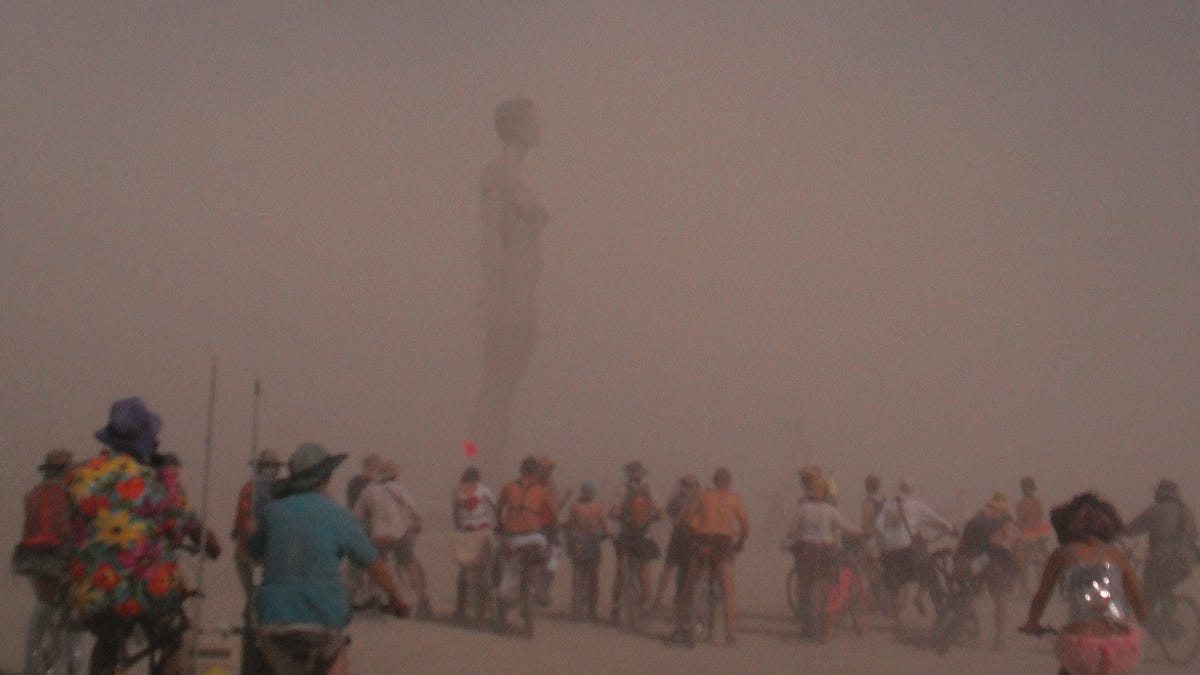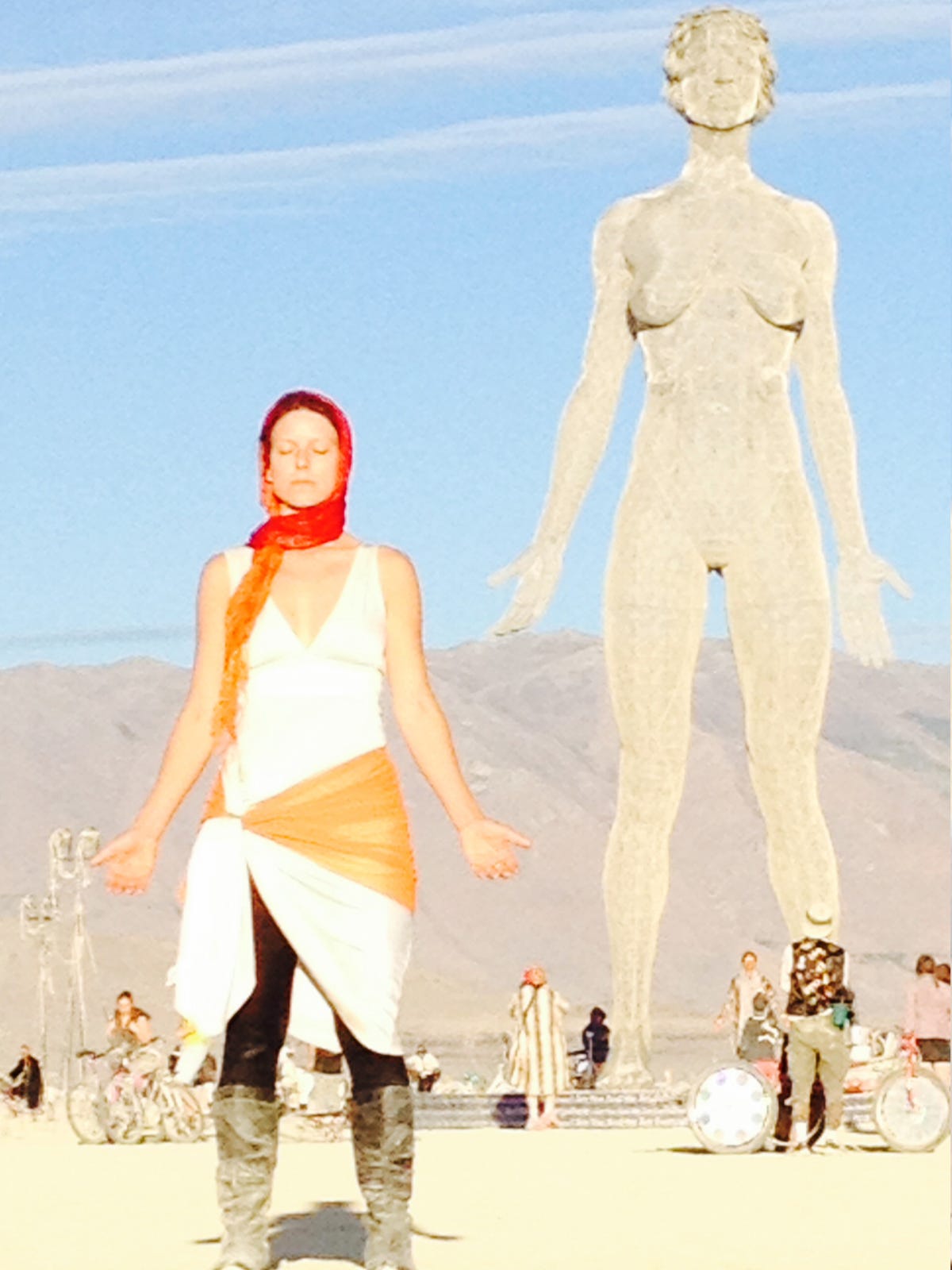Emerging from Chrysalides: Trial by Dust (Offering 8.4)
What does it take to hold onto yourself in the middle of a storm?
In the harsh, dazzling chaos of Burning Man, I found myself on the edge—of relapse, of surrender, of the unknown. This is the story of what it took to hold on.
(If you’re new to Eclosion: An Artist’s Path to Power and Peace, start at the beginning. Or visit my Memoir Hub for a full table of contents with links.)
Trial by Dust
When I was a year and a half sober, I received a scholarship to go to the Americans for the Arts Conference in Chicago. It was a solo trip—I didn’t know a single other person planning to attend the conference. I marveled at my excitement to meet and talk with a bunch of strangers. That excitement, more than anything else, helped me to see how much I’d changed in the previous eighteen months.
The trip was fantastic. I stayed at a local hostel and met a lot of interesting people during the conference. I even ran into an old roommate from Olympia on the sidewalk, someone who lived in the shared house where I’d painted that wounded tree, and who I’d subsequently lost track of. He took me on a public art tour, showing me hidden masterpieces that most visitors never see. At the conference there were a lot of arts administrators, many of whom wanted to hear about what I was doing as a working artist.
One evening the Art Institute of Chicago hosted a meet and greet for the conference attendees—miniature sandwiches and plastic wine glasses were arrayed on tall tables throughout the atrium. I mingled for a while, then went outside for some air that wasn’t laden with the smell of wine. There on the steps I fell into conversation, about art, of course, with a woman named Crimson Rose. She was a founding member of Burning Man, the otherworldly art festival and experiment in community that takes place annually in the desert of Nevada. I had never been to Burning Man, but did see its mass exodus from the Playa in the Black Rock-High Rock Desert while adventuring there years before. Crimson Rose gifted me tickets on the spot.
Tickets to Burning Man are expensive and hard to come by, so when I returned home and told Shon about this incredible opportunity, he immediately agreed to go. We planned for months, enlisting the help of friends who’d gone to Burning Man. After gathering all the gear we thought we’d need to survive the dust storms of the playa, including brand-new motorcycle goggles, we headed for Nevada. We drove Shon’s little Toyota pickup through lush Pacific Northwest forests, across the Cascade Mountains, and into the hot sagebrush-filled desert. Heat radiated off the blacktop as we neared our destination, my excitement rising with it.
Burning Man proved to be even more intense than we’d anticipated.
In recovery we talk about the acronym HALT: Hungry, Angry, Lonely, and Tired. If you’re feeling out of sorts, you may just need to eat something, or get some rest, or call someone. When I went to Burning Man, in the Black Rock-High Rock Desert, there were ever so many more triggers. A city of more than eighty thousand people grows up out of the desert, all camping in tight quarters. Stimulus is everywhere. There is searing heat and dust storms. Epic art installations and experiences straight out of Mad Max Beyond Thunderdome. There is knowing that anywhere I go, I could get drunk or high.
I am at Burning Man, and I am not yet two years sober. It is still daylight when Shon and I reach the Playa. Just getting into camp takes hours. When we finally reach registration, we get out of our truck to enter the line on foot. By this time, my chest is constricted, my breathing short. Overwhelmed by the sheer magnitude of what we are entering and near panic, I’m ready to cut and run. Seeing my need to flee, Shon takes my hand, and says, “Let’s just do the next thing. Let’s get in line. That’s all we have to do. Just get in line.” Alright, that much I can do. We get in line. Registration complete, he directs us to the next task. “Now we just need to find where we’re camping.” Then, “Now we’ll set up our tent.” With his simple guidance, keeping me focused on the next thing, my panic subsides. We meet a few people from our camp, take our first walk around the Playa, alive with light and sound, and settle in for the night.
In the morning, we join a bicycle tour of the Playa. We ride our bikes through dust storms, marveling at the towering art installations that rise from the desert like specters, hidden by the blowing alkaline dust until we are right in front of them. It is a haunting, unearthly beauty.
As Shon and I settle into a groove, we find artful encounters and opportunities to connect at every turn. This is a haven for the arts. A haven in the midst of incredibly harsh conditions.
The wind is a constant, kicking up clouds of chalky dust. It is so intense we almost constantly wear dust masks and goggles—torture in the broiling heat. To combat the dust, we pitch our tent inside of a larger tent. We lie down for the night, wind whistling through the playa, grit swirling around us. I try to sleep in my mask but it’s too much, too claustrophobic. When we awake in the morning we are covered in a layer of fine powder.
Everywhere we turn there is something new and unexpected to see. Leaving our bikes outside, we stop at an art installation in a small hut. We enter to find the hut filled with small mirrors that reflect your true self. Unlike typical household mirrors, these mirrors, built at right angles, reflect your image as you are seen by the world.
I look into a mirror and see my reflection—warped and unreal. I look in another, and another, beginning to feel panic rise once again. Is this how people really see me? With a crooked mouth and strangely shaped eyes? This reflection is a distortion of what I’ve always known to be true. Looking at myself, I feel like I’m tripping, even though I am stone cold sober.
Flooded with the revelation of who I am, I flee the hut, running out into the Playa. Shon and I dance in the wind and dust as I will myself to be present, orienting myself to this new reality. A woman stops and asks if she can take our picture. She does, then gives us the Polaroid photograph. We are ghosts dancing in the dust.
I can’t take it anymore; can no longer pretend I’m okay. I feel myself slipping. I am in crisis.
There is refuge at our camp—refuge I am in desperate need of. I tell Shon I’ll see him later and hop on my bike. I am so close to a drink. Burning Man operates on a gift economy. How easy it would be to pull over at just about any tent along the way—I would be gifted alcohol or marijuana or LSD or shrooms, no problem. I look straight ahead, and pedal for all I am worth, finding my way back to camp, a sober haven in the midst of the Black Rock Desert. I find a sober woman—my Desert Guide—who lets me spew my fears, lets me cry. She tells me that as somebody with almost two years of sobriety it is time to either fully commit to my sobriety or forget it. She asks the most important question: “How badly do you want to be sober?”
I think of how my life has transformed in the last year and three quarters. Of making it through my first holiday, just one week sober. Of being intimate with my husband and crying after because the emotions are so raw—of how tender and supportive he is. Of going to visit my family for the first time without a drop of alcohol. Of how proud of me my mom is. How I don’t want to hurt those I love with my drinking ever again. Of the art conference I went to earlier that year, which sparked this trip to Burning Man, and my realization that I was excited and happy to talk to people I didn’t know.
I think about how I am in the middle of one of the harshest, most stimulating environments I can imagine, and I am still sober; how even in my current emotional anguish, I don’t want to lose all I’ve worked for.
And I know, if I can get through this, I can go anywhere and do anything. And I can do so without taking a single drink.



